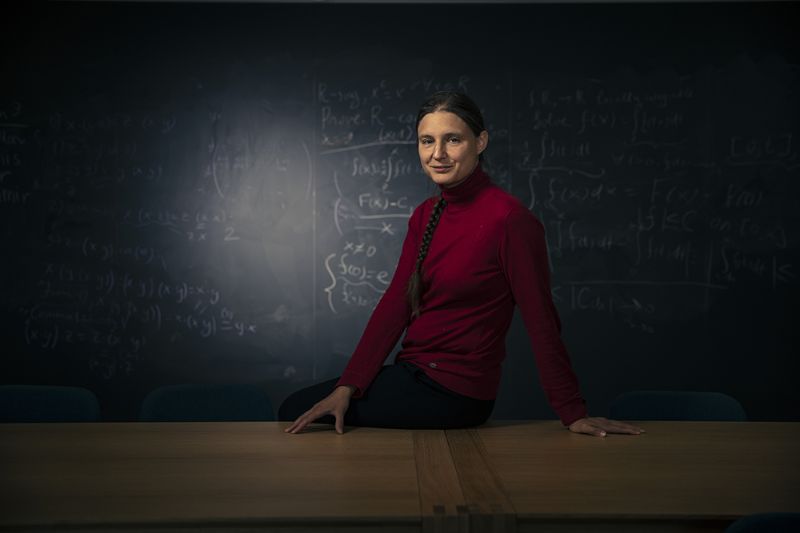“The magic of 8 and 24”
It usually starts with her black notebook, where Maryna Viazovska records the results of her thoughts, a list of complex formulas. Maryna Viazovska is a mathematician and professor at the EPFL Chair of Number Theory. Her passion is the science of arithmetic, numbers and geometric figures. She successfully participated in school mathematics competitions in her Ukrainian homeland at the age of 12. Some 25 years later in 2022, the 37-year-old received the prestigious Fields Medal, known officially as the “International Medal for Outstanding Discoveries in Mathematics”. This award, which gets its name from its Canadian benefactor, John Charles Fields (1864–1932), has been presented every four years since 1936 and is considered the “Nobel Prize of Mathematics”. Among the 60 researchers to receive the award, Viazovska was the second woman to be honoured. For the “proof that the E8 lattice provides the densest packing of identical spheres in eight dimensions and other contributions to related extremal problems”, according to the statement of the International Mathematical Union, which confers the prize.
The work sounds complicated, and it is. The fundamental question is how many identical, non-overlapping spheres can be packed into a given volume. Researchers have concerned themselves with this problem for some time. For example, German mathematician Johannes Kepler postulated in 1611 that the best way to solve this problem in three-dimensional space was by arranging the spheres into a pyramid. However, this conjecture was unproven, and it took until 1998 for a proof to be found. This question was then settled, at least in three-dimensional space. However, in mathematics, countless dimensions exist in which the same question can be posed. “What we are talking about here is pure abstraction; while a three-dimensional space has three coordinates, a point in eight-dimensional space has eight coordinates,” Viazovska says.
This is the area in which she initially conducted her research. “The question was how to optimally fill the abstract space with spheres up to the upper limit,” the researcher explains. Dimension 8 was a good choice because preliminary work had already been done in this area. For example, Massachusetts Institute of Technology (MIT) mathematician Henry Cohn and Harvard scientist Noam Elkies demonstrated more than 10 years ago that it is possible to pack the spheres almost perfectly in this dimension – perfectly within a billionth of a percent. Viazovska developed this work further by combining various fields of mathematics and also by using “modular forms” – the primary topic of her dissertation.
After two years of intensive work, she developed the definitive function and provided 23 pages of proof for the perfect packing of the spheres in eight-dimensional space in March 2016. The mathematical experts were impressed, and MIT researcher Cohn congratulated and motivated her to extend her method to dimension 24, into the “Leech lattice”, which is used to construct sphere packings that are particularly efficient in 24-dimensional space. It was a week later when Viazovska, together with Cohn and two other scientists, posted a theorem on the open-source platform arXiv.org proving the perfection of the Leech lattice packing in dimension 24, thus also confirming the importance of the idea that Viazovska originally developed for dimension 8.
EPFL took notice of the gifted young researcher and invited her to serve as an associate professor on Lake Geneva. She later published her research results in the Annals of Mathematics, a leading mathematics journal, and has been a full professor of number theory at EPFL since 2018. It’s no coincidence that she chose the university. In addition to the EPFL’s reputation, the fact that the institution helped in the establishment of a dual career was crucial. With this assistance, it was also possible for her husband, who is likewise a natural scientist, to find employment there so the family of four would be able to live and do research in one location.
Mathematics is everywhere
“I am doing basic research,” Viazovska says, “but certainly with the goal and hope in mind that these interpolation formulas can be applied in order to solve problems in areas such as differential equations or signal processing.” After all, mathematics is everywhere in everyday life, usually without people noticing. “Without mathematics, there is no Skype,” she says, “and also no optimised timetable for the Swiss train system.” However, what counts for Viazovska is “the magic of 8 and 24”. This was also the title of her acceptance speech given at the Fields Medal ceremony.
